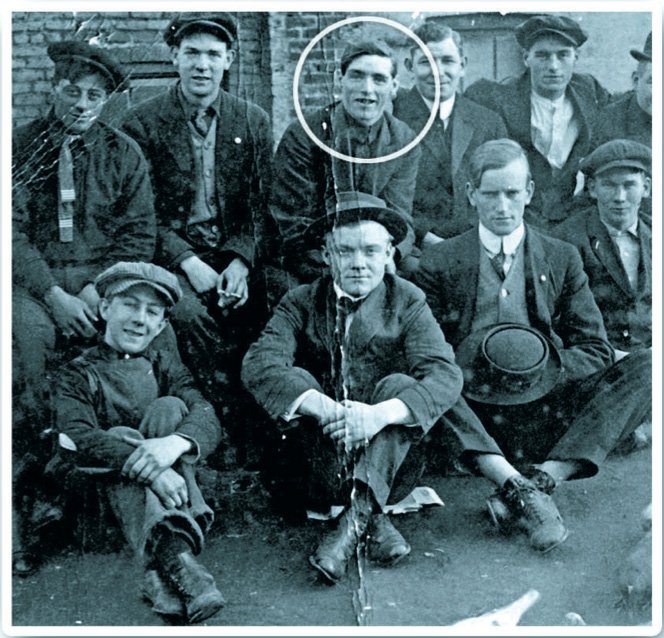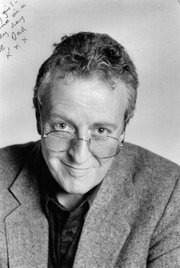New York gangster Owney Madden never wanted his story told. Even in so-called retirement in Hot Springs, he never squealed. He died in 1965, and he kept his secrets.
English author Graham Nown wrote a book about Madden, anyway: The English Godfather (1987). But Madden himself couldn’t have done better at hiding the evidence.
The book became so rare over the years, it sold for $100 and more on the used book market. It still goes for hundreds in the pristine original, hardcover edition that Ward, Lock & Co. published in Madden’s native England, never in the United States.
Ain’t it a crime, boo-hoo, as Madden’s ghost could have said, about this book gone to sleep with the fishes.
But the story isn’t over.
The same book with a different title - Arkansas Godfather: The Story of Owney Madden and How He Hijacked Middle America - is $22.50, a steal by comparison, newly released in softcover from Butler Center Books in Little Rock.
Butler Center Books manager Rod Lorenzen contributes an introduction to the new edition. He credits Nown’s “insatiable curiosity” in tracking down “the truth about a former countryman who later became one of America’s most notorious criminals.”
The introduction leaves out the detective story of Lorenzen’s own determination to find and publish the book.
Lorenzen was a bookstore owner before he went to work for the Butler Center, part of the Central Arkansas Library System’s Butler Center for Arkansas Studies. Rare books were among his specialties.
He had customers willing to pay a bag of swag for a copy of The English Godfather.
When he nabbed one, “I read it,” Lorenzen says. He discovered “a fascinating chapter about Hot Springs.”
Nown’s book fit the Butler Center’s mission of publishing stories about Arkansas, but the author died in 1997. Lorenzen began a trans-Atlantic search to find the writer’s heirs.
The mystery ends with a bang: Nown got the story. Lorenzen secured the rights to reprint it, and this might even mean that people will quit stealing it out of libraries.
Chances are that Madden would have paid for, not swiped a copy. He might have been second only to Chicago’s Al Capone as big-scale crime boss. But he stuck to his own sense of ethics, Nown writes.
Madden, according to Nown, considered himself an “honest man.”
THE GANG’S ALL HERE
Born in Leeds, England, in 1891, Owen Vincent “Owney” Madden scrapped his way through Lancashire to the docks and across to America.
Even as a boy, he had the quick fists he needed to protect his immigrant family of widowed mother and two siblings. New York greeted them with times as hard as the life they had sought to escape.
Nown recounts the lesson that turned young Owney to crime. He saw a thief his own age steal a bag of groceries. Another boy might have vowed to become a crime-fighter, but Madden took a different view. He thought, “Hell, I could do that - and better, too.”
Smart, tough and ready to move up, he not only fit the mean streets of New York, he took charge. He was the brains of the city’s most notorious street gang, the Gophers. He ran the Gotham underworld in epic style. New York’s jazzy Cotton Club was Madden’s.
Bombshell Mae West was Madden’s girlfriend on the sly and he bankrolled the start of her career. He was “so sweet, yet so vicious,” she said - the most often shot man she ever knew (11 times on one occasion).
Movie star George Raft was among Madden’s best friends, along with boxing champ “Slapsie” Maxie Rosenbloom. Practically all of New York loved him during Prohibition, when Madden’s outlaw brewery poured out 300,000 gallons of beer a day, and nobody dared to stick a finger in the foam.
The law finally jugged him for manslaughter in a gangland killing. He emerged from Sing Sing prison, and the record goes blank on the strange thing that happened next - how it was that Madden wound up in Hot Springs.
“The full story of Owney Madden,” Nown concedes, “will never be known.”
The mobster’s relocation to Arkansas in 1935 might have been his own idea, or the gang’s, or the government’s.
Perhaps it was the end result of New York Gov. Franklin D. Roosevelt’s crackdown on corruption beginning in 1930 as he groomed himself to run for the presidency in 1932.
The move might have represented some kind of agreement among all of many parties with a shared interest in being rid of Madden. It might have taken all that muscle to nudge him off to Hot Springs, where he claimed to have “retired,” but his “retirement” included an FBI agent assigned to watch him.
Watched or not, Madden soon enough returned to his old ways of keeping Hot Springs well supplied with vice. Or so it was said, although not to his face. To all appearances, he was the town’s quietest, most civic-minded resident.
Like other gangsters, Madden had been to Hot Springs before as a getaway from the pressures of underworld life in New York. Among the mobbed-up likes of Frank Costello and Benjamin “Bugsy” Siegel, the town was known as “Bubbles” for the spa water. Vacationing gangsters mingled with movie stars and millionaires, and Madden fit with the crowd.
Once he took up residence, he planted firm roots that spread from his quiet house on Grand Avenue to who knows-where. He “presided over” the Southern Club, is how people described Madden’s involvement in the Vegas-style casino and showroom. Friends of his owned the place, but the question left on the gambling table was: Who owned them?
For years, Nown wrote, Madden had brushed aside questions about when he might become a citizen of the United States. He said he would “get around to it,” but the prospect was clouded by a long-time complication: The United States didn’t want him. Madden’s way around the problem was a quarter-million dollars’ worth of payoffs, by some accounts.But the judge finally claimed to be swayed by Madden’s “reputation for goodness.”
By 1942, Madden could present himself as just another American Joe, faithfully married with a house and a lawn to keep up, and nobody had better say otherwise.
To some extent, his new image was true. Nown reports that Madden’s friends loved him, and his enemies in their graves were in no position to complain.
The mobster’s response to his new home is the big surprise in this story, and maybe to Madden, too: He liked it. He settled in. He married the postmaster’s pretty daughter, Agnes. He raised pigeons. He petted dogs. He kept his mouth shut.
The gangster’s story remained untold for good reason, Nown writes. Madden didn’t want publicity, and nobody crossed Madden. Even his fabled generosity to children and charities went unreported except by word of-mouth.
As for the extent of his criminal activities, Nown writes, “great question marks hang.”
CLUE TO WHEREABOUTS
Nown tailed Madden’s story all the way from England to Hot Springs, where he knocked on the body guarded door of Madden’s ailing old widow. The author’s English accent, identical to Madden’s, apparently persuaded her to grant him the rarity of an interview.
“I loved him,” she said of her much feared and (in Hot Springs, anyway) venerated husband, whose funeral had been respectfully attended by the mayor and the police chief.
From this, Nown understood that he wasn’t after just a two-fisted crime yarn, but also a love story better than Bonnie and Clyde’s.
Nown wrote books on everything from Victorian cooking to Sherlock Holmes. Madden’s story prompted his interest in the Prohibition era, which led to his expertise on single-malt Scotch whisky. He wrote the definitive text, Malt Whisky: A Comprehensive Guide for Both Novice and Connoisseur.
He picked up his first clue to Madden from a meeting with a certain English gent, Jimmy Murphy, once the butler for movie comedian Stan Laurel.
Laurel recommended a vacation in Hot Springs, the man said. Madden was there to greet Murphy: “The biggest gangster in New York, but he only wanted to talk about his old hometown in England.”
The author’s widow and daughter, Sylvana Nown and Rose Shaw, fill out the tale by e-mail from across the ocean.
Shaw responded to a reporter’s request for an interview: “Mum is coming around to see me later, so we will have a chat and try to answer your questions.”
Graham Nown was, first of all, “a good listener,” they say.Once he heard about Madden, he wondered, “How had a Lancashire lad, like himself, evolved to become such an infamous figure?”
“It took years of patient digging, following up every and any lead he could uncover to resurrect each fragment of the puzzle,” they remember. “He financed all the research himself, and it took him to New York and Arkansas.
“He needed to see for himself Owney’s old haunts and to soak up the atmosphere, most importantly to meet and talk with the people still living who knew him, especially Agnes [Madden’s widow].”
Nown re turned with “hand-crafted mementos from Arkansas, “which we still treasure,” they say.
The book’s English edition sold out, and a movie version seemed likely, but The English Godfather got robbed.
Even as Nown set to work on Madden’s biography he was “overtaken,” they say, by The Cotton Club (1984), the Francis Ford Coppola movie with Bob Hoskins as Madden. The movie lost at the box office to Eddie Murphy and Beverly Hills Cop. Madden slipped off the screen, back to cover as a curious footnote in Arkansas history.
“Graham never gave up hope of an American version” of the book, his widow and daughter say. “We are grateful to Rod Lorenzen for making this happen.”
BOOKED!
Prepared to negotiate for the book, Lorenzen required none of the pressure that Madden knew how to apply: The author’s family gave him the rights.
“There has been interest in this book since 1987,” he says.
Like a word of confession from Owney Madden, “it’s just been hard for people to get.”
Style, Pages 47 on 06/09/2013


